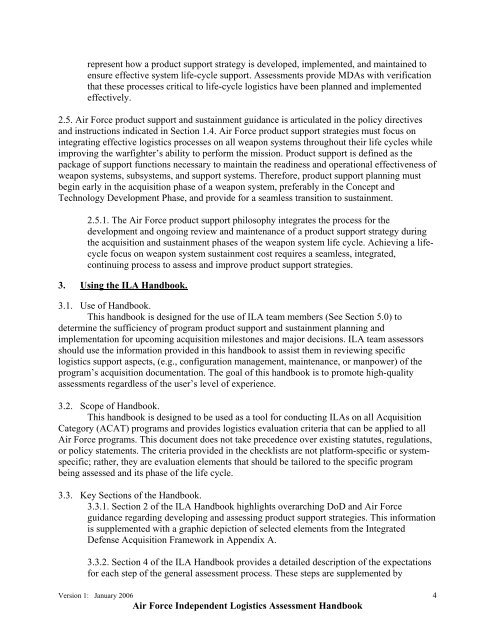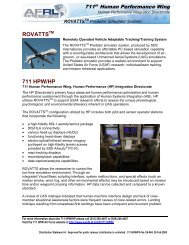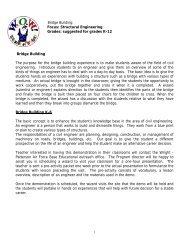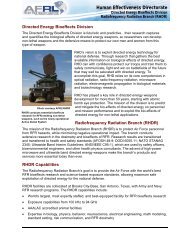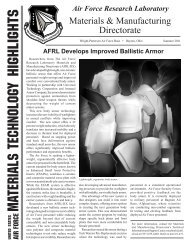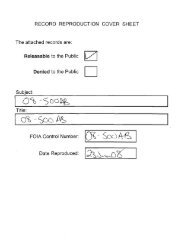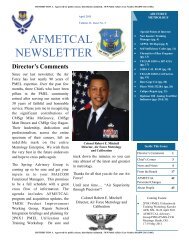USAF ILA Handbook - ACC Practice Center - Defense Acquisition ...
USAF ILA Handbook - ACC Practice Center - Defense Acquisition ...
USAF ILA Handbook - ACC Practice Center - Defense Acquisition ...
You also want an ePaper? Increase the reach of your titles
YUMPU automatically turns print PDFs into web optimized ePapers that Google loves.
epresent how a product support strategy is developed, implemented, and maintained to<br />
ensure effective system life-cycle support. Assessments provide MDAs with verification<br />
that these processes critical to life-cycle logistics have been planned and implemented<br />
effectively.<br />
2.5. Air Force product support and sustainment guidance is articulated in the policy directives<br />
and instructions indicated in Section 1.4. Air Force product support strategies must focus on<br />
integrating effective logistics processes on all weapon systems throughout their life cycles while<br />
improving the warfighter’s ability to perform the mission. Product support is defined as the<br />
package of support functions necessary to maintain the readiness and operational effectiveness of<br />
weapon systems, subsystems, and support systems. Therefore, product support planning must<br />
begin early in the acquisition phase of a weapon system, preferably in the Concept and<br />
Technology Development Phase, and provide for a seamless transition to sustainment.<br />
2.5.1. The Air Force product support philosophy integrates the process for the<br />
development and ongoing review and maintenance of a product support strategy during<br />
the acquisition and sustainment phases of the weapon system life cycle. Achieving a lifecycle<br />
focus on weapon system sustainment cost requires a seamless, integrated,<br />
continuing process to assess and improve product support strategies.<br />
3. Using the <strong>ILA</strong> <strong>Handbook</strong>.<br />
3.1. Use of <strong>Handbook</strong>.<br />
This handbook is designed for the use of <strong>ILA</strong> team members (See Section 5.0) to<br />
determine the sufficiency of program product support and sustainment planning and<br />
implementation for upcoming acquisition milestones and major decisions. <strong>ILA</strong> team assessors<br />
should use the information provided in this handbook to assist them in reviewing specific<br />
logistics support aspects, (e.g., configuration management, maintenance, or manpower) of the<br />
program’s acquisition documentation. The goal of this handbook is to promote high-quality<br />
assessments regardless of the user’s level of experience.<br />
3.2. Scope of <strong>Handbook</strong>.<br />
This handbook is designed to be used as a tool for conducting <strong>ILA</strong>s on all <strong>Acquisition</strong><br />
Category (ACAT) programs and provides logistics evaluation criteria that can be applied to all<br />
Air Force programs. This document does not take precedence over existing statutes, regulations,<br />
or policy statements. The criteria provided in the checklists are not platform-specific or systemspecific;<br />
rather, they are evaluation elements that should be tailored to the specific program<br />
being assessed and its phase of the life cycle.<br />
3.3. Key Sections of the <strong>Handbook</strong>.<br />
3.3.1. Section 2 of the <strong>ILA</strong> <strong>Handbook</strong> highlights overarching DoD and Air Force<br />
guidance regarding developing and assessing product support strategies. This information<br />
is supplemented with a graphic depiction of selected elements from the Integrated<br />
<strong>Defense</strong> <strong>Acquisition</strong> Framework in Appendix A.<br />
3.3.2. Section 4 of the <strong>ILA</strong> <strong>Handbook</strong> provides a detailed description of the expectations<br />
for each step of the general assessment process. These steps are supplemented by<br />
Version 1: January 2006 4<br />
Air Force Independent Logistics Assessment <strong>Handbook</strong>


